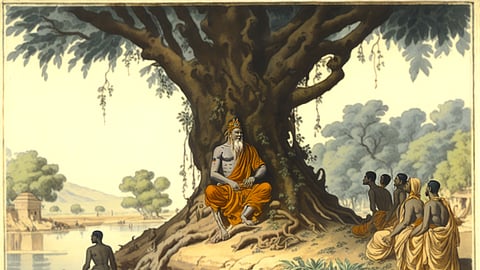- Commentary
- History Vignettes
- Notes on Culture
- Dispatches
- Podcasts
- Indian LanguagesIndian Languages
- Support

THE PREVIOUS EPISODE CONCLUDED with a simple declaration: that Dharma and education should ideally form an integral whole.
We can illustrate this with a couple of examples.
One of the fundamental questions that our Dharmasastras pose and answer is this: who knows the secret of Dharma and its most accurate application in life? The answer: that illiterate old woman in the village. The king would accept her verdict as final while deciding disputes. That old woman might have never gone to school, etc., but was profoundly educated by living her culture over a lifetime. It was this experience of deep and purposeful living that gave that woman a juridical authority greater than the king. Such old women were respected because they were the living repositories of a timeless, unbroken cultural inheritance, which no book or teacher can teach. Even today, there are countless such elderly women in our villages who are invariably invited to all kinds of functions…for consultation on the most accurate way to perform a custom, the most appropriate song to sing for the occasion, the best name to give to an infant, etc.
The second example is rather recent. Just fifty years ago, the mark of a truly educated person was the extent and depth of his or her knowledge of our epics, our sacred literature, classical poetry, social and cultural customs and appropriate conduct and norms of behaviour. That person necessarily need not have gone to school or learnt how to read and write. We shall explore this point in a little more detail later.
FUNDAMENTALLY, A COUNTRY’S APPROACH TO EDUCATION depends on how it regards human beings: as mere economic units who are capable of nothing higher than earning money, consuming material goods, and performing the basic animal functions of eating, sleeping and reproduction. The contemporary term “human resources” is a direct outcome of this conception of the human being.
Or, does the education system place human beings on a higher plane? Like Swami Vivekananda did: “Each soul is potentially divine. The goal is to manifest this divinity by controlling nature, external and internal. Do this either by work, or worship, or psychic control, or philosophy.”
As we’re familiar, the former approach is the Western approach and the latter is the Sanatana approach. Unfortunately, India over the last century, especially after Independence has mindlessly imitated the western model. The result is the industrialization of education in its worst form. Even worse than that is the fact that India’s far superior system and heritage of education is on the verge of total extinction. We can look at another famous quote of Swami Vivekananda:
The child is taken to school, and the first thing he learns is that his father is a fool, the second thing that his grandfather is a lunatic, the third thing that all his teachers are hypocrites, the fourth, that all the sacred books are lies! By the time he is sixteen he is a mass of negation, lifeless and boneless…We have learnt only weakness.
But instead of correcting this system, we have made weakness our lifestyle to such an extent that we can no longer see what the great Swami foresaw. Let’s look at another quote from Radhakumud Mookerji:
In our educational heritage, knowledge did not merely exist in the form of Manuscripts...which could be stored up like furniture, for knowledge was the furniture of the mind. Learning was not reading but realisation, and knowledge was to be in the blood, as an organic part of one’s own self.
Our ancient and unbroken system of education began to collapse the day Hindus unthinkingly swallowed the BIG LIE which was relentlessly broadcast by British propaganda: literacy = education. This propaganda went hand in hand with the pitiless destruction of our Gurukulas and other traditional institutions of learning. This is what Ananda Coomaraswamy diagnosed as early as 1947:
the literacy actually produced by compulsory mass education often involves little or no more than an ability and the will to read the newspapers and advertisements…this is a language of exclusively external relationships, a tradesman’s tongue. Competition is the life of trade, and gangsters must have rivals.
However, this is not to condemn or degrade the innate value of literacy and the acquisition of formal academic or professional qualifications but to bring our attention to the loss that Hindus as a whole have suffered as a result of unconsciously or consciously giving up the invaluable aspects of their cultural heritage in exchange for this soulless system that has reduced the whole of humanity to individual economic units.
In fact, Hindu history offers the best proof to the contrary: that we advanced in both material sciences and worldly learning, all of which went hand in hand to preserve and develop our culture.
To be continued
The Dharma Dispatch is now available on Telegram! For original and insightful narratives on Indian Culture and History, subscribe to us on Telegram.
